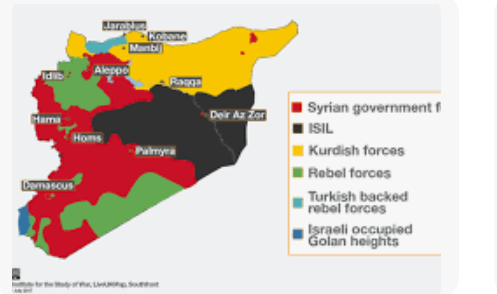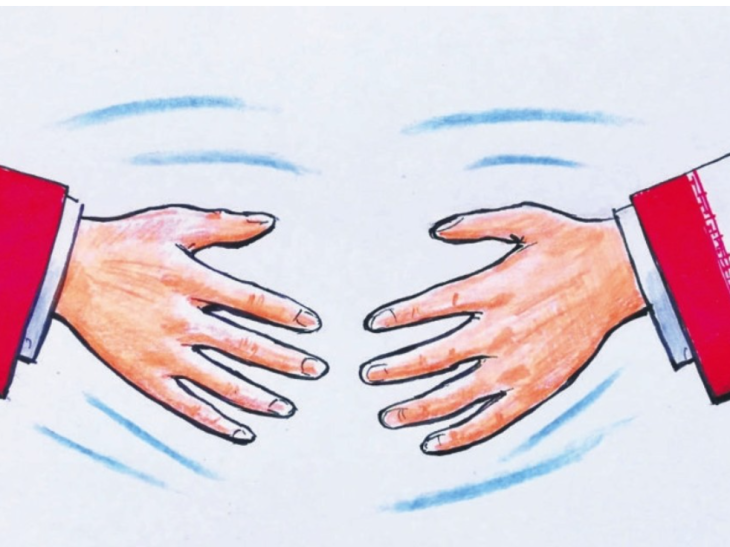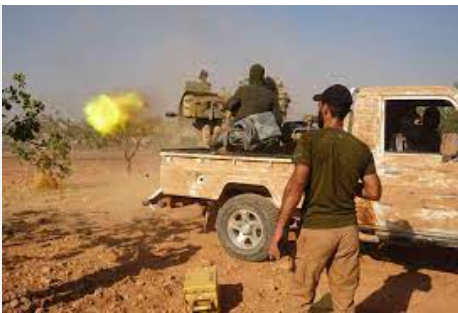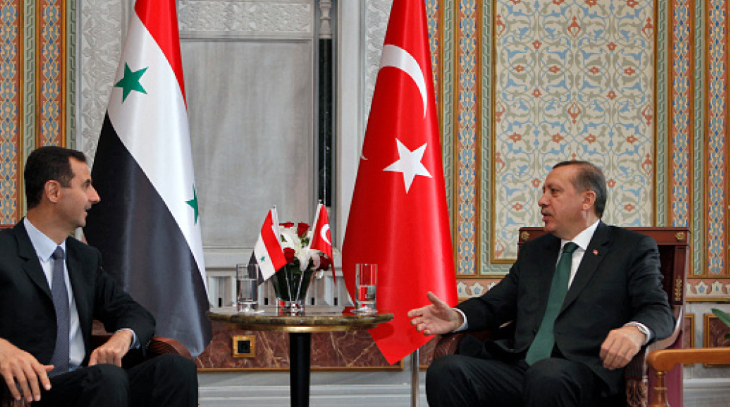“Syria is prime strategic real estate in the Middle East conflict”, argues Jonathan Spyer, a director of research at the Middle East Forum and director of the Middle East Center for Reporting and Analysis. “It is a vital linking point in the contiguous line of control that Tehran seeks to establish from the Iran-Iraq border to the Mediterranean Sea, taking in three nominal Arab states, Iraq, Syria and Lebanon”. This is conflict that deeply involves Turkey, hence PA Turkey shares excerpts from Spyer’s observations, who recently visited the war-torn country.
Broken Syria is a vital node in that broader picture in which Iranian ambitions across the region are colliding with the interests and allies of the West. Syria appears to be the space in which Israel has chosen to most determinedly contest this issue. But Israel's covert war with Iran is only one component in a broader struggle for mastery now under way in the Middle East.
In late March, I spent 10 days travelling in Syria. My intention was to reach the Euphrates Valley and the province of Deir al Zur in the southeast of the country. There, this process and this contest may be viewed in their clearest form.
The "great game" is a term used by historians to describe the strategic contest between Britain and Russia in the 19th century for domination of the area comprising then-Persia and Afghanistan. There is today a similar contest under way between the West and Iran in the Middle East.
A broken country
Syria, in 2024, does not really exist. That is, the Syrian Arab Republic, of which Bashar al-Assad is the President, with its two-starred flag and its seat in the UN General Assembly, is not the real power in the country. Observers of the country have watched as the Assad regime, once the most powerful and centralised of Arab dictatorships, has lost control of large swathes of Syrian territory. Even in the areas where Assad maintains nominal control, his is not the voice that matters, or the deciding hand.
Rather, Syria today is parcelled out into three areas of control. And in all three of these zones, the will of international powers is the vital element. The three areas are that of the Assad regime itself, which controls a little more than 60 per cent of the country, and in which the presence and will of Iran is the decisive factor; the area ruled by the Kurdish-led Autonomous Authority of North-East Syria (AANES), whose continued viability is underwritten by the presence of 900 US troops in the just under 30 per cent of Syria that it holds; and an enclave in the northwest of the country controlled by Turkey, in partnership with the Sunni Islamist militias who first raised the banner of revolt against the Assad regime in 2012.
[embed]https://www.youtube.com/watch?v=rr0N0pAuVH0&t=9s[/embed]
Further in, the de facto control of the AANES has similarly become routine. Its checkpoints, its red, green and yellow flags, the portraits of the martyrs from the war against ISIS that one sees everywhere in these dusty towns east of the Euphrates, all have acquired a feel of solidity about them. This authority was hard won, at high cost, against the Sunni jihadis, and against the Assad regime. In late 2019, after then president Donald Trump abruptly announced a US withdrawal, conquest by the Turks or a return of the regime looked imminent.
In practice, however, neither happened. The Turks bit off a chunk of territory, the regime and the Russians established limited presences east of the river. But on the ground, the AANES remained, and remains, in control, with the presence of the Americans their essential guarantor. For as long as the US chooses to stay, this situation will prevail. Which means, of course, that it's all a lot more precarious than it looks.
"The SDF don't want to get into conflict with other armies and states. We want the autonomous area to continue to serve the interests of the people ... the existence of many international and regional powers and the battles between them are creating sometimes suffering for the people of the region," Ilham Ahmed tells me, as we sit in her office. Ahmed is the former co-president of AANES, and is today its head of foreign affairs. She is a veteran activist of the Democratic Union Party, the dominant political formation in this area.
"We understand that there is pressure on the US administration to withdraw from Syria. Turkey is doing this, so it will be able to fill the gap. Iran is also applying pressure, in a different way ... the Syrian regime wants to bring everything back to how it was before 2011. ISIS sees all this as an opportunity to make chaos. All this is turning our region into an area where other powers come to fight, and this is a problem for us."
The Road to Deir al Zur
Ilham Ahmed's weariness with the machinations of powers in her homeland is entirely understandable. But with central authority in the country broken, Syria's current status as an arena for the contest between stronger forces, local and global, looks set to continue.
Tehran seeks to build an area of control from the Iraq-Iran border to the Mediterranean. In Iraq and Lebanon, the IRGC's proxy militias already hold sway and have freedom of movement and activity. The AANES area, which takes in Syria east of the Euphrates, forms a kind of de facto barrier to the consolidation of Iran's sought-after contiguity. So the Iranians are trying to force the US to quit this zone, in the belief that this will pave the way for the entry of the Assad regime and its Iranian ally into the area.
The point of greatest tension is the lower Euphrates River Valley, and the province of Deir al Zur. Here, the two sides face one another directly. It is one of the inflection points in the current regional struggle, and the action is correspondingly intense.
Deir al Zur has the atmosphere common to war zones and militarised spaces everywhere. Military vehicles speed down dusty roads, there are checkpoints every few kilometres. As we took the road south, I noted the transformation in the look of the SDF fighters. Another symbol of change and consolidation. In the early days of the ISIS war, their lack of equipment was to a seasoned eye a matter of some concern.
The contest in Deir al Zur, in which Iran and its allies are seeking to degrade and dismantle the SDF and cause the Americans to leave, has three main aspects: these are rocket and missile attacks, ground incursions, and clandestine warfare.
Regarding the first, pro-Iran militias periodically launch missile and drone attacks at the SDF in Deir al-Zur. The last such attack took place on February 5, and targeted the Omar oilfield, where both the SDF and US forces have facilities. Six SDF fighters were killed. More than 170 attacks on US forces in Iraq, Syria and Jordan have taken place since October 7. Most of the attacks are claimed by "Islamic Resistance in Iraq", a term of convenience used by a number of IRGC-controlled Iraqi Shia militias.
On the ground, local militiamen recruited, according to local sources, in an operation co-ordinated by Lebanese Hezbollah personnel are carrying out daily attacks against SDF positions along the Euphrates. The gunmen cross the river in small boats, open fire and quickly return. Sometimes, two or three such attacks take place daily.
"The regime and Iran tried to take advantage of the chaos," says Jiyan Abu Saleh, an official of the SDF in Deir al Zur. "They tried to convince local people that they could get money and power if they came to their side. In the first stage, Iran was only providing money and weapons for the tribes. When the situation got harder, Iran-supported militias started intervening directly.'
A member of the influential Akidat tribe, one Ibrahim Khalil al Hifl, is now located on the western side of the river, where he is directing ongoing efforts to raise the tribes against the SDF, in co-operation with the Iranians and Hizballah.
A day after we met Abu Saleh in Deir al Zur, Israel launched a major raid on Iranian positions west of the Euphrates, a few kilometres away. The Albukamal Border Crossing is the narrow bottleneck through which Iranian weapons and materiel pass, on their way to Lebanon or the West Bank.
The large number of positions in the area are a natural target. Fourteen members of the Iranian Revolutionary Guards were killed in the strike, along with a Syrian civil engineer, according to the opposition-linked Syrian Observatory for Human Rights. The Iran-backed groups launched a drone at US positions west of the river in an attempt at retaliation. The raid was part of a series of Israeli air operations, which included also the killing of General Zahedi in Damascus, and a major Israeli raid in Aleppo, in Syria's north.
Where are we heading?
Syria is today transformed into a confrontation point between external powers. The Euphrates River Valley – where the Iranians and their militia proxies face the Americans and their Kurdish allies, and Israel hits at Iran's attempt to transport weapons to its proxies further west – is one of the focal points of the conflict system that has breached its weakened borders.
That conflict system is the new "great game" under way now in the Middle East. It is nowhere close to conclusion and has almost certainly not yet even reached its height. The central confrontation between Iran and Israel may be about to escalate further, following the killing of General Mohammed Reza Zahedi. Prediction is a fool's game in the Middle East. All the same, it may be foreseen with confidence that the peaceful development and progress hoped for by Ilham Ahmed of the AANES appears as far away for Syria now as at any time in its modern history. In the meantime, the long struggle for advantage conducted across remote, largely ignored but strategically vital spaces like Deir al Zur and the Euphrates River Valley continues each day.
[embed]https://www.youtube.com/watch?v=CE1HkXdjjoI&t=2s[/embed]
Jonathan Spyer is director of research at the Middle East Forum and director of the Middle East Center for Reporting and Analysis. He is author of Days of the Fall: A Reporter's Journey in the Syria and Iraq Wars (2018).
 suriye-bolunmus
suriye-bolunmus





